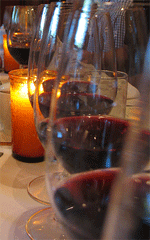Thinking of hosting your own wine tasting? Here is a guide to a few helpful hints to make your wine tasting event a successful one. There are many types of wine tasting events, some more serious than others so keep your guest list in mind when planning which route to take.

For a less serious wine tasting party we suggest getting a group together of about 12-16 people. Since this is going to be a wine tasting party and not a dinner party, do not feel compelled to provide a full meal as a nice fruit and cheese plate and some small finger foods would do nicely. At the very least have some neutral crackers on the table that guests can cleanse their pallets between tasting. However, if you are planning on hosting a “wine pairing” then you will want to make sure that you have the appropriate prepared and there are several online resources that can help you with this.
Choose about 4-6 different wines to taste. Here you can get creative by either choosing all white all red or both. You can even be as specific as variety such as Cabernet Sauvignon or Pinot Noir but it is not necessary. Or more specifically, you can host a vertical wine tasting, which means tasting a few different vintages from the same make. So for example, could try
Robert Mondovi Cabernet Sauvignon 2004, 2005, 2006. Or you could do the opposite and host a horizontal wine tasting, which choosing to taste one varietal from a single year, produced by various wine makers. Or you can limit your wine tasting down to a certain region such as
California wines,
Washington wines or
New York wines, the possibilities are endless. Do get a range of wines from different price points, as it’s always interesting to see if the most expensive is truly the most popular.
Before you start your testing cover each bottle with a paper bag so that the labels are hidden. Cover your tasting table with a white table cloth so that the wine color can easily be identified, you will also want to make sure you have good lighting as well. For each wine you will be tasting each guest will need a new glass, so if possible set out enough glasses at each place setting ahead of time. If you do not have enough glasses, then be sure to have a dump bucket on the table so that guests can empty their glasses between tasting rounds. Do not rinse glasses with water as the water will dilute the wine.
Each guest will also need a score card and a pencil. You can find many score card template online or purchase a wine tasting kit which should come equipped with them.
See our guide on wine tasting and etiquette.
Pour about 1.5-2 ounces of wine in each glass (one bottle per 10 people, approximately). Note that whites are typically tasted before reds.
Wine tasting parties are a great way to bring friends and family together for an evening of fun. Here are a few addition online resources that can help with additional ideas and supplies:
www.blindwine.com
www.ehow.com
www.decanter.com
www.wineenthusiast.com
Wine tasting serving temperature reference
The temperature that a wine is served at can greatly affect the way it tastes and smells. Lower temperatures will emphasize acidity and tannins while muting the aromatics. Higher temperatures will minimize acidity and tannins while increasing the aromatics. Master of Wine Jancis Robinson recommends the following temperature range for different styles of wine.
Light bodied sweet dessert wines: 41-50°F (5-10°C)
White sparkling wines: (Ex: Champagne) 43-50°F (6-10°C)
Aromatic, light bodied white: (Ex: Riesling, Sauvignon blanc) 46-54°F (8-12°C)
Red sparkling wines: (Ex: Sparkling Shiraz) 50-54°F (10-12°C)
Medium bodied whites: (Ex: Chablis, Semillon) 50-54°F (10-12°C)
Full bodied dessert wines: (Ex: Oloroso Sherry) 46-54°F (8-12°C)
Light bodied red wines: (Ex: Beaujolais, Provence rosé) 50-54°F (10-12°C)
Full bodied white wines: (Ex: Oaked Chardonnay) 54-61°F (12-16°C)
Medium bodied red wines: (Ex: Grand Cru Burgundy) 57-63°F (14-17°C)
Full bodied red wines: (Ex: Cabernet Sauvignon) 59-64°F (15-18°C)